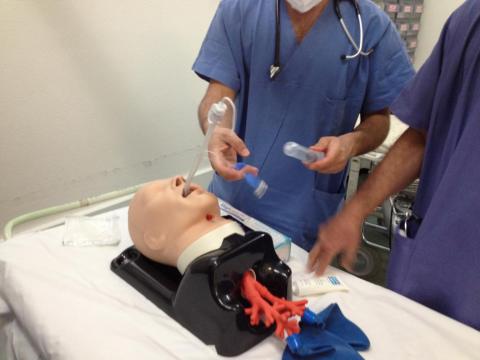Guide
Download in PDF format
Follow the video tutorial series on YouTube
Upon opening the package, control that the device is not damaged, that the stylet is properly positioned inside the tube with its distal end inside the esophageal cuff. The proximal cuff should be deflated before insertion. Then proceed to properly lubricate the device with a water-soluble lubricant. Inflate with 8 ml of air the distal cuff in order to facilitate the introduction.
Keep the patient's head in a neutral position and introduce the device into the oropharyngeal tract: hold the device with the dominant hand keeping the spindle and the tube together and using the non-dominant hand to advance the device into the oral cavity. Slide it along the palate until it reaches the correct depth, indicated by the demarcation line located at the proximal end of the tube between the dental arches. This insertion depth corresponds to the placement of the distal cuff in the esophagus and the proximal one in the supraglottic region (hypopharynx).

Inflate the esophageal cuff with air until you obtain an adequate pressure to isolate the distal esophagus, and therefore the stomach, preventing gastric reflux. Remove the spindle. Inflate the proximal cuff without exceeding 50-60 cm H2O and connect the tube to a ventilation circuit or a self-expanding balloon to ventilate the patient. Verification of correct positioning is done through the auscultatory method and the capnographic method.
If it is not possible to ventilate the patient despite the execution of the procedure as indicated, it is possible that the tube is not positioned correctly and that the distal cuff has entered the trachea. In this case, in the absence of signs of effective ventilation, it will be necessary to remove the device and repeat the introduction maneuver with the aid of a laryngoscope to guide the positioning of the distal cuff in the esophagus under vision.
Once rightly introduced, the device in this configuration allows for effective ventilation of the patient and protects the airways from regurgitation and inhalation of material coming from the stomach, complying with the aims of the SADs.

If the clinical situation requires it, the Spritztube offers a possibility to perform an orotracheal intubation, without having to replace the device, but simply changing its configuration by placing its proximal part into the trachea (like in a normal intubation procedure). It is possible to perform intubation with various methods:
- - With a classic laryngoscope
- - With a video laryngoscope
- - With a Bonfils type rigid fiberscope or video stylet
- - With a flexible fiberscope
In the classic laryngoscopy, once the patient is sedated and curarized, disconnect the ventilation circuit, deflate the proximal cuff, introduce the blade in the throat, lift the epiglottis to access the glottis and insert the tube in the trachea. If the intubation proves difficult, you can revert to ventilation simply by re-inflating the proximal cuff and reconnecting the tube to the ventilation circuit, to take time to consider an alternative intubation method. Upon successful intubation, inflate the proximal cuff with sufficient pressure to occlude the tracheal lumen and continue ventilating the patient.
For intubation with a video laryngoscope (Glidescope, McGrath), disconnect the ventilation circuit, deflate the proximal cuff, introduce the blade in the throat to view the glottis. Insert the stylet in the proximal end of the tube and introduce it into the trachea. Re-inflate the proximal cuff and ventilate the patient, with auscultation and capnography checks.
To use a Bonfils type rigid fiberscope disconnect the ventilation circuit and deflate the proximal cuff. Before introducing the endoscope, to ensure better visibility, it is recommended to aspirate any supraglottic secretions with a suction tube guided through the Spritztube. Now it is possible to insert the Bonfils through the Spritztube and push it to the distal opening, rotating it to get the right view angle of the glottis. Having reached the larynx under the instrument’s guidance, insert the Spritztube into the trachea, re-inflate the proximal cuff and ventilate the patient, with auscultation and capnography checks.
The last possible technique uses the support of a flexible endoscope or VS. After aspiration of the supraglottic region, the instrument is introduced through the appropriate bronchoscopy and aspiration hole present on the Mount catheter, without interrupting the ventilation. Move forward until you pass the distal end of the tube and, after viewing the glottic rim, pass into the trachea, pushing the fiberscope to the carina; in case of videostylet, stop at the laryngeal entrance. At this point, briefly disconnect the ventilation circuit, deflate the proximal cuff and push the tube into the trachea using the fiberscope or VS as a guide. Once the tube’s distal end is correctly positioned in the trachea, inflate the cuff and ventilate the patient.


